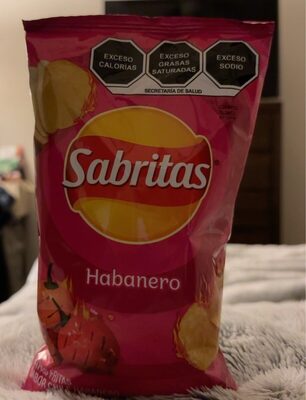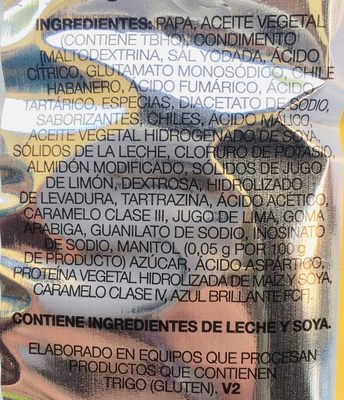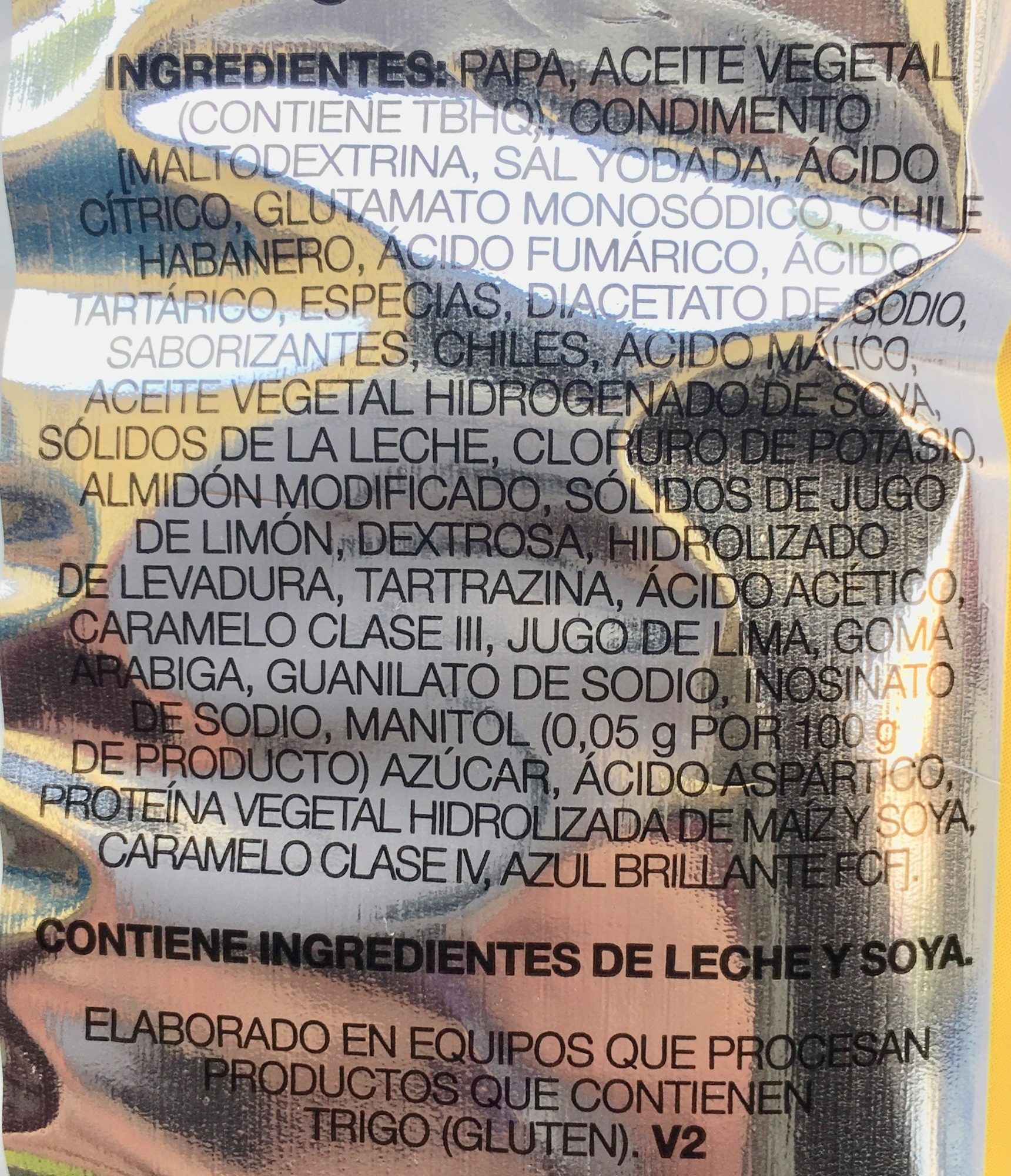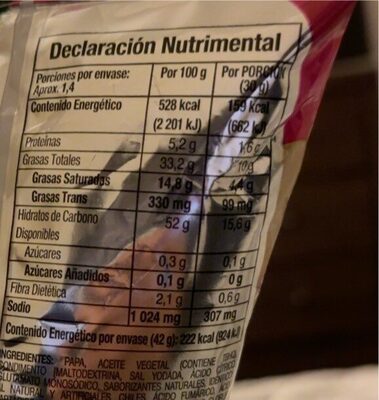Help us make food transparency the norm!
As a non-profit organization, we depend on your donations to continue informing consumers around the world about what they eat.
The food revolution starts with you!
Sabritas Habanero - 42 g
Sabritas Habanero - 42 g
This product page is not complete. You can help to complete it by editing it and adding more data from the photos we have, or by taking more photos using the app for Android or iPhone/iPad. Thank you!
×
Barcode: 7501011137431 (EAN / EAN-13)
Common name: Papas fritas sabor chile habanero
Quantity: 42 g
Packaging: es:Bolsa de plastico
Categories: Plant-based foods and beverages, Plant-based foods, Snacks, Cereals and potatoes, Salty snacks, Appetizers, Chips and fries, Crisps, Potato crisps
Origin of ingredients: Mexico
Manufacturing or processing places: México
Stores: Soriana, Walmar, Bodega aurrera, Oxxo
Countries where sold: Mexico
Matching with your preferences
Health
Ingredients
-
28 ingredients
Spanish: PAPA, ACEITE VEGETAL (CONTIENE TBH CONDIMENTO MALTODEXTRINA, SAL YODADA, ACIDO CITRICO, GLUTAMATO MONOSÓDICO, CHILE HABANERO, ACIDO FUMÁRICO, ÁCIDO TARTÁRICO, ESPECIAS, DIACETATO DE SODIO SABORIZANTES, CHILES, ACIDO MÁLCO ACEITE VEGETAL HIDROGENADO DE SOYA SOLIDOS DE LA LECHE, CLORURO DE POTASIO ALMIDÓN MODIFICADO, SOLDOS DE JUGO DE LIMON, DEXTROSA, HIDROLIZADO DE LEVADURA, TARTRAZINA, ÁCIDO ACETICO, CARAMELO CLASE I, JUGO DE LIMA, GOMA ARABIGA, GUANILATO DE SODIO, INOSINATO DE SODIO, MANITOL (0,05 g POR DE PRODUCTO 100 g) AZÚCAR, ÁCIDO ASPARTiCO, PROTEINA VEGETAL HIDROLZADA DE MAIZ Y SOYA CARAMELO CLASE I AZUL BRILLANTE FCF.Allergens: Milk, SoybeansTraces: es:leche-y-soya-trigo-gluten
Food processing
-
Ultra processed foods
Elements that indicate the product is in the 4 - Ultra processed food and drink products group:
- Additive: E102 - Tartrazine
- Additive: E414 - Acacia gum
- Additive: E421 - Mannitol
- Additive: E621 - Monosodium glutamate
- Additive: E627 - Disodium guanylate
- Additive: E631 - Disodium inosinate
- Ingredient: Dextrose
- Ingredient: Glucose
Food products are classified into 4 groups according to their degree of processing:
- Unprocessed or minimally processed foods
- Processed culinary ingredients
- Processed foods
- Ultra processed foods
The determination of the group is based on the category of the product and on the ingredients it contains.
Additives
-
E102 - Tartrazine
Tartrazine: Tartrazine is a synthetic lemon yellow azo dye primarily used as a food coloring. It is also known as E number E102, C.I. 19140, FD&C Yellow 5, Acid Yellow 23, Food Yellow 4, and trisodium 1--4-sulfonatophenyl--4--4-sulfonatophenylazo--5-pyrazolone-3-carboxylate-.Tartrazine is a commonly used color all over the world, mainly for yellow, and can also be used with Brilliant Blue FCF -FD&C Blue 1, E133- or Green S -E142- to produce various green shades.Source: Wikipedia
-
E260 - Acetic acid
Acetic acid: Acetic acid , systematically named ethanoic acid , is a colorless liquid organic compound with the chemical formula CH3COOH -also written as CH3CO2H or C2H4O2-. When undiluted, it is sometimes called glacial acetic acid. Vinegar is no less than 4% acetic acid by volume, making acetic acid the main component of vinegar apart from water. Acetic acid has a distinctive sour taste and pungent smell. In addition to household vinegar, it is mainly produced as a precursor to polyvinyl acetate and cellulose acetate. It is classified as a weak acid since it only partially dissociates in solution, but concentrated acetic acid is corrosive and can attack the skin. Acetic acid is the second simplest carboxylic acid -after formic acid-. It consists of a methyl group attached to a carboxyl group. It is an important chemical reagent and industrial chemical, used primarily in the production of cellulose acetate for photographic film, polyvinyl acetate for wood glue, and synthetic fibres and fabrics. In households, diluted acetic acid is often used in descaling agents. In the food industry, acetic acid is controlled by the food additive code E260 as an acidity regulator and as a condiment. In biochemistry, the acetyl group, derived from acetic acid, is fundamental to all forms of life. When bound to coenzyme A, it is central to the metabolism of carbohydrates and fats. The global demand for acetic acid is about 6.5 million metric tons per year -Mt/a-, of which approximately 1.5 Mt/a is met by recycling; the remainder is manufactured from methanol. Vinegar is mostly dilute acetic acid, often produced by fermentation and subsequent oxidation of ethanol.Source: Wikipedia
-
E262 - Sodium acetates
Sodium acetate: Sodium acetate, CH3COONa, also abbreviated NaOAc, is the sodium salt of acetic acid. This colorless deliquescent salt has a wide range of uses.Source: Wikipedia
-
E262ii - Sodium diacetate
Sodium acetate: Sodium acetate, CH3COONa, also abbreviated NaOAc, is the sodium salt of acetic acid. This colorless deliquescent salt has a wide range of uses.Source: Wikipedia
-
E297 - Fumaric acid
Fumaric acid: Fumaric acid or trans-butenedioic acid is the chemical compound with the formula HO2CCH=CHCO2H. It is produced in eukaryotic organisms from succinate in complex 2 of the electron transport chain via the enzyme succinate dehydrogenase. It is one of two isomeric unsaturated dicarboxylic acids, the other being maleic acid. In fumaric acid the carboxylic acid groups are trans -E- and in maleic acid they are cis -Z-. Fumaric acid has a fruit-like taste. The salts and esters are known as fumarates. Fumarate can also refer to the C4H2O2−4 ion -in solution-.Source: Wikipedia
-
E330 - Citric acid
Citric acid is a natural organic acid found in citrus fruits such as lemons, oranges, and limes.
It is widely used in the food industry as a flavor enhancer, acidulant, and preservative due to its tart and refreshing taste.
Citric acid is safe for consumption when used in moderation and is considered a generally recognized as safe (GRAS) food additive by regulatory agencies worldwide.
-
E334 - L(+)-tartaric acid
Tartaric acid: Tartaric acid is a white, crystalline organic acid that occurs naturally in many fruits, most notably in grapes, but also in bananas, tamarinds, and citrus. Its salt, potassium bitartrate, commonly known as cream of tartar, develops naturally in the process of winemaking. It is commonly mixed with sodium bicarbonate and is sold as baking powder used as a leavening agent in food preparation. The acid itself is added to foods as an antioxidant and to impart its distinctive sour taste. Tartaric is an alpha-hydroxy-carboxylic acid, is diprotic and aldaric in acid characteristics, and is a dihydroxyl derivative of succinic acid.Source: Wikipedia
-
E414 - Acacia gum
Gum arabic: Gum arabic, also known as acacia gum, arabic gum, gum acacia, acacia, Senegal gum and Indian gum, and by other names, is a natural gum consisting of the hardened sap of various species of the acacia tree. Originally, gum arabic was collected from Acacia nilotica which was called the "gum arabic tree"; in the present day, gum arabic is collected from acacia species, predominantly Acacia senegal and Vachellia -Acacia- seyal; the term "gum arabic" does not indicate a particular botanical source. In a few cases so‐called "gum arabic" may not even have been collected from Acacia species, but may originate from Combretum, Albizia or some other genus. Producers harvest the gum commercially from wild trees, mostly in Sudan -80%- and throughout the Sahel, from Senegal to Somalia—though it is historically cultivated in Arabia and West Asia. Gum arabic is a complex mixture of glycoproteins and polysaccharides. It is the original source of the sugars arabinose and ribose, both of which were first discovered and isolated from it, and are named after it. Gum arabic is soluble in water. It is edible, and used primarily in the food industry as a stabilizer, with EU E number E414. Gum arabic is a key ingredient in traditional lithography and is used in printing, paint production, glue, cosmetics and various industrial applications, including viscosity control in inks and in textile industries, though less expensive materials compete with it for many of these roles. While gum arabic is now produced throughout the African Sahel, it is still harvested and used in the Middle East.Source: Wikipedia
-
E421 - Mannitol
Mannitol: Mannitol is a type of sugar alcohol which is also used as a medication. As a sugar, it is often used as a sweetener in diabetic food, as it is poorly absorbed from the intestines. As a medication, it is used to decrease pressure in the eyes, as in glaucoma, and to lower increased intracranial pressure. Medically, it is given by injection. Effects typically begin within 15 minutes and last up to 8 hours.Common side effects from medical use include electrolyte problems and dehydration. Other serious side effects may include worsening heart failure and kidney problems. It is unclear if use is safe in pregnancy. Mannitol is in the osmotic diuretic family of medications and works by pulling fluid from the brain and eyes.The discovery of mannitol is attributed to Joseph Louis Proust in 1806. It is on the World Health Organization's List of Essential Medicines, the most effective and safe medicines needed in a health system. The wholesale cost in the developing world is about US$1.12 to 5.80 a dose. In the United States, a course of treatment costs $25 to 50. It was originally made from the flowering ash and called manna due to its supposed resemblance to the Biblical food. Mannitol is on the World Anti-Doping Agency's banned drug list due to concerns that it may mask other drugs.Source: Wikipedia
-
E621 - Monosodium glutamate
Monosodium glutamate: Monosodium glutamate -MSG, also known as sodium glutamate- is the sodium salt of glutamic acid, one of the most abundant naturally occurring non-essential amino acids. Glutamic acid is found naturally in tomatoes, grapes, cheese, mushrooms and other foods.MSG is used in the food industry as a flavor enhancer with an umami taste that intensifies the meaty, savory flavor of food, as naturally occurring glutamate does in foods such as stews and meat soups. It was first prepared in 1908 by Japanese biochemist Kikunae Ikeda, who was trying to isolate and duplicate the savory taste of kombu, an edible seaweed used as a base for many Japanese soups. MSG as a flavor enhancer balances, blends, and rounds the perception of other tastes.The U.S. Food and Drug Administration has given MSG its generally recognized as safe -GRAS- designation. A popular belief is that large doses of MSG can cause headaches and other feelings of discomfort, known as "Chinese restaurant syndrome," but double-blind tests fail to find evidence of such a reaction. The European Union classifies it as a food additive permitted in certain foods and subject to quantitative limits. MSG has the HS code 29224220 and the E number E621.Source: Wikipedia
-
E627 - Disodium guanylate
Disodium guanylate: Disodium guanylate, also known as sodium 5'-guanylate and disodium 5'-guanylate, is a natural sodium salt of the flavor enhancing nucleotide guanosine monophosphate -GMP-. Disodium guanylate is a food additive with the E number E627. It is commonly used in conjunction with glutamic acid. As it is a fairly expensive additive, it is not used independently of glutamic acid; if disodium guanylate is present in a list of ingredients but MSG does not appear to be, it is likely that glutamic acid is provided as part of another ingredient such as a processed soy protein complex. It is often added to foods in conjunction with disodium inosinate; the combination is known as disodium 5'-ribonucleotides. Disodium guanylate is produced from dried seaweed and is often added to instant noodles, potato chips and other snacks, savory rice, tinned vegetables, cured meats, and packaged soup.Source: Wikipedia
-
E631 - Disodium inosinate
Disodium inosinate: Disodium inosinate -E631- is the disodium salt of inosinic acid with the chemical formula C10H11N4Na2O8P. It is used as a food additive and often found in instant noodles, potato chips, and a variety of other snacks. Although it can be obtained from bacterial fermentation of sugars, it is often commercially prepared from animal sources.Source: Wikipedia
Ingredients analysis
-
May contain palm oil
Ingredients that may contain palm oil: Vegetable oil
-
Vegan status unknown
Unrecognized ingredients: es:contiene-tbh-condimento-maltodextrina, es:chile-habanero, es:diacetato-de-sodio-saborizantes, es:acido-malco-aceite-vegetal-hidrogenado-de-soya-solidos-de-la-leche, es:cloruro-de-potasio-almidon-modificado, es:soldos-de-jugo-de-limon, es:hidrolizado-de-levadura, es:caramelo-clase-i, es:acido-aspartico, es:proteina-vegetal-hidrolzada-de-maiz-y-soya-caramelo-clase-i-azul-brillante-fcfSome ingredients could not be recognized.
We need your help!
You can help us recognize more ingredients and better analyze the list of ingredients for this product and others:
- Edit this product page to correct spelling mistakes in the ingredients list, and/or to remove ingredients in other languages and sentences that are not related to the ingredients.
- Add new entries, synonyms or translations to our multilingual lists of ingredients, ingredient processing methods, and labels.
If you would like to help, join the #ingredients channel on our Slack discussion space and/or learn about ingredients analysis on our wiki. Thank you!
-
Vegetarian status unknown
Unrecognized ingredients: es:contiene-tbh-condimento-maltodextrina, es:chile-habanero, es:diacetato-de-sodio-saborizantes, es:acido-malco-aceite-vegetal-hidrogenado-de-soya-solidos-de-la-leche, es:cloruro-de-potasio-almidon-modificado, es:soldos-de-jugo-de-limon, es:hidrolizado-de-levadura, es:caramelo-clase-i, es:acido-aspartico, es:proteina-vegetal-hidrolzada-de-maiz-y-soya-caramelo-clase-i-azul-brillante-fcfSome ingredients could not be recognized.
We need your help!
You can help us recognize more ingredients and better analyze the list of ingredients for this product and others:
- Edit this product page to correct spelling mistakes in the ingredients list, and/or to remove ingredients in other languages and sentences that are not related to the ingredients.
- Add new entries, synonyms or translations to our multilingual lists of ingredients, ingredient processing methods, and labels.
If you would like to help, join the #ingredients channel on our Slack discussion space and/or learn about ingredients analysis on our wiki. Thank you!
-
Details of the analysis of the ingredients
We need your help!
Some ingredients could not be recognized.
We need your help!
You can help us recognize more ingredients and better analyze the list of ingredients for this product and others:
- Edit this product page to correct spelling mistakes in the ingredients list, and/or to remove ingredients in other languages and sentences that are not related to the ingredients.
- Add new entries, synonyms or translations to our multilingual lists of ingredients, ingredient processing methods, and labels.
If you would like to help, join the #ingredients channel on our Slack discussion space and/or learn about ingredients analysis on our wiki. Thank you!
es: PAPA, ACEITE VEGETAL, CONTIENE TBH CONDIMENTO MALTODEXTRINA, SAL YODADA, ACIDO CITRICO, GLUTAMATO MONOSÓDICO, CHILE HABANERO, ACIDO FUMÁRICO, ÁCIDO TARTÁRICO, ESPECIAS, DIACETATO DE SODIO SABORIZANTES, CHILES, ACIDO MÁLCO ACEITE VEGETAL HIDROGENADO DE SOYA SOLIDOS DE LA LECHE, CLORURO DE POTASIO ALMIDÓN MODIFICADO, SOLDOS DE JUGO DE LIMON, DEXTROSA, HIDROLIZADO DE LEVADURA, TARTRAZINA, ÁCIDO ACETICO, CARAMELO CLASE I, JUGO DE LIMA, GOMA ARABIGA, GUANILATO DE SODIO, INOSINATO DE SODIO, MANITOL 0.05%, AZÚCAR, ÁCIDO ASPARTiCO, PROTEINA VEGETAL HIDROLZADA DE MAIZ y SOYA CARAMELO CLASE I AZUL BRILLANTE FCF- PAPA -> en:potato - vegan: yes - vegetarian: yes - ciqual_food_code: 4003 - percent_min: 3.57142857142857 - percent_max: 98.8
- ACEITE VEGETAL -> en:vegetable-oil - vegan: yes - vegetarian: yes - from_palm_oil: maybe - percent_min: 0.05 - percent_max: 49.425
- CONTIENE TBH CONDIMENTO MALTODEXTRINA -> es:contiene-tbh-condimento-maltodextrina - percent_min: 0.05 - percent_max: 32.9666666666667
- SAL YODADA -> en:iodised-salt - vegan: yes - vegetarian: yes - ciqual_food_code: 11058 - percent_min: 0.05 - percent_max: 2.5583333333332
- ACIDO CITRICO -> en:e330 - vegan: yes - vegetarian: yes - percent_min: 0.05 - percent_max: 2.5583333333332
- GLUTAMATO MONOSÓDICO -> en:e621 - vegan: yes - vegetarian: yes - percent_min: 0.05 - percent_max: 2.5583333333332
- CHILE HABANERO -> es:chile-habanero - percent_min: 0.05 - percent_max: 2.5583333333332
- ACIDO FUMÁRICO -> en:e297 - vegan: yes - vegetarian: yes - percent_min: 0.05 - percent_max: 2.5583333333332
- ÁCIDO TARTÁRICO -> en:e334 - vegan: yes - vegetarian: yes - percent_min: 0.05 - percent_max: 2.5583333333332
- ESPECIAS -> en:spice - vegan: yes - vegetarian: yes - percent_min: 0.05 - percent_max: 2.5583333333332
- DIACETATO DE SODIO SABORIZANTES -> es:diacetato-de-sodio-saborizantes - percent_min: 0.05 - percent_max: 2.5583333333332
- CHILES -> en:chili-pepper - vegan: yes - vegetarian: yes - ciqual_food_code: 20151 - percent_min: 0.05 - percent_max: 2.5583333333332
- ACIDO MÁLCO ACEITE VEGETAL HIDROGENADO DE SOYA SOLIDOS DE LA LECHE -> es:acido-malco-aceite-vegetal-hidrogenado-de-soya-solidos-de-la-leche - percent_min: 0.05 - percent_max: 2.5583333333332
- CLORURO DE POTASIO ALMIDÓN MODIFICADO -> es:cloruro-de-potasio-almidon-modificado - percent_min: 0.05 - percent_max: 2.5583333333332
- SOLDOS DE JUGO DE LIMON -> es:soldos-de-jugo-de-limon - percent_min: 0.05 - percent_max: 2.5583333333332
- DEXTROSA -> en:dextrose - vegan: yes - vegetarian: yes - ciqual_proxy_food_code: 31016 - percent_min: 0.05 - percent_max: 2.5583333333332
- HIDROLIZADO DE LEVADURA -> es:hidrolizado-de-levadura - percent_min: 0.05 - percent_max: 2.5583333333332
- TARTRAZINA -> en:e102 - vegan: yes - vegetarian: yes - percent_min: 0.05 - percent_max: 2.5583333333332
- ÁCIDO ACETICO -> en:e260 - vegan: yes - vegetarian: yes - percent_min: 0.05 - percent_max: 2.5583333333332
- CARAMELO CLASE I -> es:caramelo-clase-i - percent_min: 0.05 - percent_max: 2.5583333333332
- JUGO DE LIMA -> en:lime-juice - vegan: yes - vegetarian: yes - ciqual_food_code: 13067 - percent_min: 0.05 - percent_max: 2.5583333333332
- GOMA ARABIGA -> en:e414 - vegan: yes - vegetarian: yes - percent_min: 0.05 - percent_max: 2.5583333333332
- GUANILATO DE SODIO -> en:e627 - vegan: maybe - vegetarian: maybe - percent_min: 0.05 - percent_max: 2.5583333333332
- INOSINATO DE SODIO -> en:e631 - vegan: maybe - vegetarian: maybe - percent_min: 0.05 - percent_max: 2.5583333333332
- MANITOL -> en:e421 - vegan: yes - vegetarian: yes - percent_min: 0.05 - percent: 0.05 - percent_max: 0.05
- AZÚCAR -> en:sugar - vegan: yes - vegetarian: yes - ciqual_proxy_food_code: 31016 - percent_min: 0 - percent_max: 0.05
- ÁCIDO ASPARTiCO -> es:acido-aspartico - percent_min: 0 - percent_max: 0.05
- PROTEINA VEGETAL HIDROLZADA DE MAIZ y SOYA CARAMELO CLASE I AZUL BRILLANTE FCF -> es:proteina-vegetal-hidrolzada-de-maiz-y-soya-caramelo-clase-i-azul-brillante-fcf - percent_min: 0 - percent_max: 0.05
Nutrition
-
Bad nutritional quality
This product is not considered a beverage for the calculation of the Nutri-Score.
Positive points: 2
- Proteins: 3 / 5 (value: 5.2, rounded value: 5.2)
- Fiber: 2 / 5 (value: 2.1, rounded value: 2.1)
- Fruits, vegetables, nuts, and colza/walnut/olive oils: 0 / 5 (value: 0, rounded value: 0)
Negative points: 26
- Energy: 6 / 10 (value: 2201, rounded value: 2201)
- Sugars: 0 / 10 (value: 0.3, rounded value: 0.3)
- Saturated fat: 10 / 10 (value: 14.8, rounded value: 14.8)
- Sodium: 10 / 10 (value: 1024, rounded value: 1024)
The points for proteins are not counted because the negative points are greater or equal to 11.
Nutritional score: (26 - 2)
Nutri-Score:
-
Nutrient levels
-
Fat in high quantity (33.2%)
What you need to know- A high consumption of fat, especially saturated fats, can raise cholesterol, which increases the risk of heart diseases.
Recommendation: Limit the consumption of fat and saturated fat- Choose products with lower fat and saturated fat content.
-
Saturated fat in high quantity (14.8%)
What you need to know- A high consumption of fat, especially saturated fats, can raise cholesterol, which increases the risk of heart diseases.
Recommendation: Limit the consumption of fat and saturated fat- Choose products with lower fat and saturated fat content.
-
Sugars in low quantity (0.3%)
What you need to know- A high consumption of sugar can cause weight gain and tooth decay. It also augments the risk of type 2 diabetes and cardio-vascular diseases.
Recommendation: Limit the consumption of sugar and sugary drinks- Sugary drinks (such as sodas, fruit beverages, and fruit juices and nectars) should be limited as much as possible (no more than 1 glass a day).
- Choose products with lower sugar content and reduce the consumption of products with added sugars.
-
Salt in high quantity (2.56%)
What you need to know- A high consumption of salt (or sodium) can cause raised blood pressure, which can increase the risk of heart disease and stroke.
- Many people who have high blood pressure do not know it, as there are often no symptoms.
- Most people consume too much salt (on average 9 to 12 grams per day), around twice the recommended maximum level of intake.
Recommendation: Limit the consumption of salt and salted food- Reduce the quantity of salt used when cooking, and don't salt again at the table.
- Limit the consumption of salty snacks and choose products with lower salt content.
-
-
Nutrition facts
Nutrition facts As sold
for 100 g / 100 mlAs sold
per serving (30 g)Compared to: Potato crisps Energy 2,201 kj
(528 kcal)660 kj
(158 kcal)+1% Fat 33.2 g 9.96 g +7% Saturated fat 14.8 g 4.44 g +299% Trans fat 0.33 g 0.099 g +2,192% Carbohydrates 52 g 15.6 g -3% Sugars 0.3 g 0.09 g -85% Added sugars 0.1 g 0.03 g -87% Fiber 2.1 g 0.63 g -49% Proteins 5.2 g 1.56 g -14% Salt 2.56 g 0.768 g +88% Fruits‚ vegetables‚ nuts and rapeseed‚ walnut and olive oils (estimate from ingredients list analysis) 0.893 % 0.893 %
Environment
-
Eco-Score B - Low environmental impact
⚠ ️Select a country in order to include the full impact of transportation.The Eco-Score is an experimental score that summarizes the environmental impacts of food products.→ The Eco-Score was initially developped for France and it is being extended to other European countries. The Eco-Score formula is subject to change as it is regularly improved to make it more precise and better suited to each country.Life cycle analysis
-
Average impact of products of the same category: A (Score: 88/100)
Category: Potato crisps
Category: Potato crisps
- PEF environmental score: 0.22 (the lower the score, the lower the impact)
- including impact on climate change: 1.54 kg CO2 eq/kg of product
Stage Impact Agriculture
61.9 %Processing
17.8 %Packaging
10.9 %Transportation
7.2 %Distribution
2.2 %Consumption
0.0 %
Bonuses and maluses
-
Origins of ingredients with a high impact
Malus: -3
Environmental policy: -3
Transportation: 0
Origin of the product and/or its ingredients % of ingredients Impact Mexico 100 %High
-
Packaging with a medium impact
Malus: -10
Shape Material Recycling Impact 1 Bag Plastic High
Eco-Score for this product
-
Impact for this product: B (Score: 75/100)
Product: Sabritas Habanero - 42 g
Life cycle analysis score: 88
Sum of bonuses and maluses: -13
Final score: 75/100
-
Carbon footprint
-
Equal to driving 0.8 km in a petrol car
154 g CO² per 100g of product
The carbon emission figure comes from ADEME's Agribalyse database, for the category: Potato crisps (Source: ADEME Agribalyse Database)
Stage Impact Agriculture
53.6 %Processing
15.0 %Packaging
18.2 %Transportation
11.9 %Distribution
1.3 %Consumption
0.0 %
Packaging
-
Packaging with a medium impact
-
Packaging parts
1 x Bag (Plastic)
-
Packaging materials
Material % Packaging weight Packaging weight per 100 g of product Plastic
-
Transportation
-
Origins of ingredients
Origins of ingredients with a high impact
Origin of the product and/or its ingredients % of ingredients Impact Mexico 100 %High
Report a problem
-
Incomplete or incorrect information?
Category, labels, ingredients, allergens, nutritional information, photos etc.
If the information does not match the information on the packaging, please complete or correct it. Open Food Facts is a collaborative database, and every contribution is useful for all.
Data sources
Product added on by openfoodfactsmx4
Last edit of product page on by tasja.
Product page also edited by kiliweb, openfoodfactsmx, packbot, yuka.sY2b0xO6T85zoF3NwEKvlk1YWoXhkjnKOwfmgRK57-eJCa7RSoh4uorfKKs.










